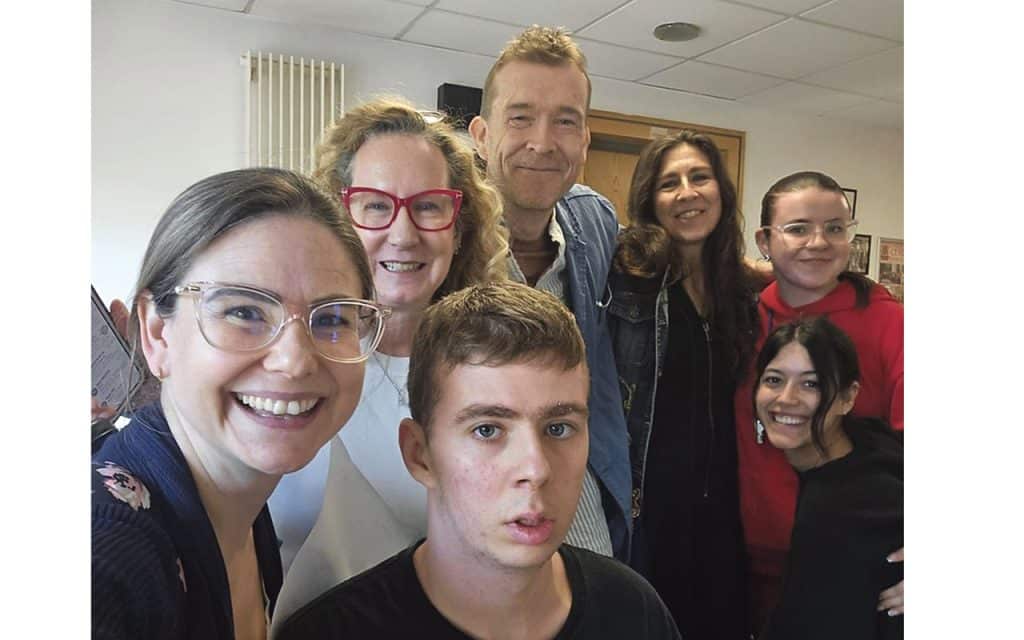Adrienne Murphy, mother and S2C practitioner, shares how her non-verbal autistic son has learned to communicate through a life-changing breakthrough method called ‘Spell 2 Communicate’.
During a recent visit to my 22-year-old autistic son Caoimh’s house – where he lives with the support of a team of social care workers – he tells me off with characteristically succinct, articulate language, in that assertive, “I’m my own person” tone that young adults use with their parents.
Caoimh manages this even though he can neither speak nor handwrite. The complex movement/fine motor skills required for these forms of communication never developed for Caoimh. This is because he’s dyspraxic: he lives his life with brain-body disconnect.

So how does my son tell me to back off with my own agenda? Caoimh is amongst the first wave of nonspeaking autistic people in Ireland to have been taught the gross motor skill – using hinging arm movement as opposed to dexterous fingers – of accurate purposeful pointing at letters on a letterboard.
The letterboard, like an archery target, is held upright in front of him, so that he can use the arm movement skills he’s acquired – which direct his pointed index finger – to aim and fire.
At his house, Caoimh is provoked into giving out when I produce the book that ‘we’ are reading – a novel called ‘The Demi-Gods’ by James Stephens.
There are many people who’d consider me mad to think that someone as apparently disabled as Caoimh – who often finds it hard to stay still, tends to pace about droning loudly and wordlessly, and spends a lot of time regulating himself on an adult swing – how someone who presents as he does could cognitively grasp an adult-aged novel, never mind express a language-based opinion on it.
The author James Stephens was heavily influenced by the mystical thought introduced to Ireland during the Irish Literary Revival. I’d presumed that Caoimh would be interested in Stephens’ novel, because Caoimh also has a poetic mystical streak. This streak is one of the many personality traits that I started to learn about Caoimh when he was 11-years-old, when I’d finally found a way to unlock him – after a decade of failed methods – into real linguistic communication.
But when I take Stephens’ book out of my bag, Caoimh quickly shoves it back in again. I see that I’m ‘gatekeeping’ my adult disabled son: projecting onto him what I’m guessing he’d like. I need to ask Caoimh his own thoughts, instead of presuming or guessing. Fortunately – unlike, as yet, the majority of the 30 million non-speakers in the world – Caoimh has a way to express his own thoughts.
I produce Caoimh’s laminated letterboard. I hold it carefully in the correct position, so that he doesn’t have to cross his midline to be able to point to the letters on the left with his right index finger. Crossing his midline to point is nigh impossible for Caoimh to do, as it is for many non-speakers.
I ask Caoimh what wants to do. “Not read really boring books,” he writes. “Home is the place where eastern forms of philosophy are read.”
Caoimh has high support needs; epilepsy which can lead to mania; and the type of autism that, until very recently, was routinely coupled with the qualifiers ‘severe’, ‘low-functioning’, ‘non-verbal’ and ‘cognitively-impaired’.
I was indoctrinated into that dehumanising, scientifically inaccurate language during Caoimh’s early years. Now I’ve unlearned it. ‘Presume competence’ is my mantra. It is far less dangerous to overestimate rather than to underestimate a person’s intelligence – especially a dyspraxic person, whose body, due to body-brain disconnect, doesn’t reflect their thoughts, creating an outer appearance that doesn’t match their inner world.
Consistent, skillfully coached target training on the letterboard, followed by ongoing target practice, is what has enabled Caoimh to spell to communicate. Recently he’s moved these skills to a keyboard positioned at an angle on a desk.
That Caoimh shows his own agency when he spells to communicate has been validated by state-paid psychological assessment. He used this method to write essays in school – one of the first non-speakers in Ireland to do so.
I taught Caoimh the motor skill of purposeful letterboard pointing when he was aged 11 to 12. Now, a decade later, I’m one of Ireland’s first Certified S2C (Spelling 2 Communicate) practitioners. And I’m bringing this new-to-Ireland communication breakthrough to West Cork, where I visit regularly, and from whence my father hailed.
‘Nonspeaker’ is an umbrella term. It includes children and adults – autistic and with other conditions such as Down’s, Angelman, Fragile X and cerebral palsy – whose motor-sensory differences mean that they can’t use speech as a robust and reliable form of communication. These people may have little or no speech, like Caoimh; minimal speech (perhaps be able to say single words or phrases, but be unable to communicate spontaneous complex thoughts through speech); or unreliable speech, such as repetitive quotes from films or ads.
The communication method I originally used to unlock Caoimh was the Rapid Prompting Method (RPM). In 2019, we moved to S2C, the method developed by US speech and language therapist, Elizabeth Vosseller. S2C is overseen by the professional body, the International Association for Spelling as Communication (I-ASC), and is based on the science of sensory-motor and regulation.
Caoimh’s spelling movements are slow by neurotypical standards. They require a great deal of effort and concentration on his part. He needs the support of expertly trained S2C Communication and Regulation Partners (CRPs) who he knows and trusts.
S2C enables Caoimh to express any thought he has, no matter how complex. He can communicate in real language. No more having to search for symbols or pictures, in books and devices, that can only approximate what he really wants to say. Once Caoimh could express anything he wanted through spelling in language, he literally threw the picture exchange communication systems we’d been trying for years over walls and in the bin. He wrecked the electronic gizmos they were on – which were creating communication-blocking obsessions and compulsive motor loops – by soaking them under the tap.
I taught Caoimh the motor skills to spell in a similar way that, for example, piano teachers coach students on how to reach the intended keys through practicing scales repeatedly. It’s with daily practice over time that piano students acquire the motor automaticity through muscle memory that enables them to play music. Caoimh’s body gradually learned, through skillfully-directed practice over time, to synchronise with his mind to reach his intended letters.
We practiced hard for 18 months, often twice a day when Caoimh was able. There were interruptions for days and even weeks in our practice, when Caoimh was too impacted by his complex, anxiety-inducing co-occurring conditions to be able to work. But we pushed on, until Caoimh eventually acquired the automatic muscle memory to ‘say’ anything he wants on the letterboard.
“My body won’t do what my brain asks it to do. My body does things I don’t want it to do.” This was how Caoimh described his main challenge when he was 13-years-old. His was not a cognitive or language deficit, but a body-based condition that creates a locked-in syndrome.
I never heard the word “dyspraxia” used by any of the many professionals we met until Caoimh was at least 14.
Throughout his childhood, I was told that as well as autistic, Caoimh was “severely intellectually disabled”, to the point that he could barely understand the most basic language.
Yet I kept seeing flashes of intelligence. When he was five, at a time when he was being drilled into trying to make speech sounds, Caoimh replayed a video clip incessantly from the animated film ‘Valiant’, in which a character, under pressure to confess, says “I’ll never talk.” At the same time, a psychologist urged us to pare back the language we used around Caoimh to the barest, baby-level essentials, because otherwise we would confuse him.
One of the first things Caoimh told me when he’d practiced letter-pointing accuracy to the stage that he could apply it to saying anything he wanted, was that he’d taught himself to read when he was a toddler, but that he couldn’t demonstrate this to anyone until he’d been taught how to spell to communicate ten years later. (No one in school had deemed Caoimh intelligent enough to teach him the alphabet, never mind to read.)
For our family, Caoimh acquiring the ability to spell to communicate meant that he was at last able to reveal who he really is beneath his brain-body disconnect – a linguistically-gifted, deep, funny kind person. It was like watching him step out of solitary confinement. I wrote about Caoimh’s journey into communication in a series of national newspaper articles.
As an S2C Practitioner, it’s beautiful to witness the joyful unfolding as other families “find” their nonspeaking loved ones along this journey to real communication.
There will be a S2C presentation on the new breakthrough communication method for children and adults who have zero, minimal or unreliable speech on Friday, October 17, from 6.30-8.30pm, at Skibbereen Community Resource Centre, North Street in Skibbereen.
The presentation will include a talk by West Cork local author David Mitchell, co-translator of ‘The Reason I Jump’. All welcome. Event is free but places are limited. Booking essential. Contact Adrienne Murphy on 086 363 2554.
S2C one-to-one sessions for nonspeaking, minimally-speaking and unreliably-speaking children and adults with Certified S2C Practitioners Adrienne Murphy and Anna Lechleiter (www.palz.ie) will take place at the same venue on Saturday, October 18, from 9am-5pm. Suitable for autism, Down, Angelman, cerebral palsy etc. Limited spaces, booking essential. There is a charge for these sessions. Contact Adrienne Murphy on 086 363 2554.
www.s2cwithadrienne and www.i-asc.org


